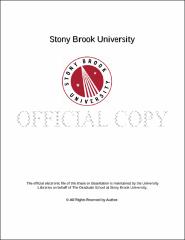| dc.identifier.uri | http://hdl.handle.net/1951/59935 | |
| dc.identifier.uri | http://hdl.handle.net/11401/71474 | |
| dc.description.sponsorship | This work is sponsored by the Stony Brook University Graduate School in compliance with the requirements for completion of degree. | en_US |
| dc.format | Monograph | |
| dc.format.medium | Electronic Resource | en_US |
| dc.language.iso | en_US | |
| dc.publisher | The Graduate School, Stony Brook University: Stony Brook, NY. | |
| dc.type | Thesis | |
| dcterms.abstract | Transportation accounts for 70% of oil consumption, and yet only 10-20% the fuel energy is used for vehicle mobility. One of the important losses is the energy dissipation in suspension vibration. The objectives of this thesis are to investigate energy recovery from vehicle suspensions by answering two questions: (1) how much energy is available while meeting the primary functions of shock absorbers? (2) how can the wasted energy be converted efficiently to electricity? To answer the first question, a vehicle-ground model, including the stochastic property of road roughness, vehicle parameters, travelling speed, is created with analysis of ride comfort, road safety, and vibration energy induced by road roughness. We found that the dissipative power from all four shock absorbers for a typical mid-size passenger car on ISO class B (good), C (average), and D (poor) roads are approximately 100, 400, 1600 Watts respectively. The sensitivity of the power generation, ride comfort and ride safety to various operational vehicle parameters are further analyzed. Results indicate the power generation is mainly depended on the tire stiffness in which the higher tire stiffness is, the more power generation. However, higher tire stiffness will cause a less comfort and more dangerous ride. Therefore, larger sprung mass will be preferred for achieving a more comfort and safer ride to compromise the negative effects of high tire stiffness. More importantly, the suspension damping also plays as an important role on ride comfort and safety aspects. A more comfortable ride can be accomplished with softer damper. As a tradeoff, the probability of losing ground contact increases which will cause handling issues and safety hazards. In addition to numerical analysis, experiments are carried out to estimate the dissipated power by measuring the relative displacement of shock absorber on both campus road and highway at different vehicle speeds. Road profile in space domain is then revealed as the shock displacement profile in time domain. The mean power is calculated with the known velocity profile differentiated from displacement profile and the damping coefficient. Results validate the numerical results in which the higher vehicle speeds result in more dissipative power from vehicle suspension systems. To answer the second question, we designed and compared different electromagnetic (EM) shock absorbers, potentially retrofitted into car suspensions. Two approaches are taken to increase power generation: to increase the flux density B [T] and to boost up the motion. The first type is linear EM harvesters with implementation of both axial and radial magnets. A double layered configuration is favored to increase the flux density inside the air gap. Electromagnetic finite element analysis indicates that we are able to increase the power generation 8 times and energy density by a factor of 5 comparing to the performance of initially designed linear EM. The second type is rotational harvesters with motion magnification mechanism. Two EM shock absorbers using rack pinion and ball screw mechanisms are designed and tested in lab to evaluate the harvester performances. Both rotational harvesters are able to generate more than 100 watts of power. However, there are other forces revealed in rotational harvesters besides damping force. The system is also experiencing frictional and stiffness forces in which further modeling works are needed to acquire better understanding on the harvester dynamics. The performances of all three electromagnetic harvesters are then compared and evaluated. | |
| dcterms.available | 2013-05-22T17:35:53Z | |
| dcterms.available | 2015-04-24T14:47:41Z | |
| dcterms.contributor | Zuo, Lei , Kao, Imin | en_US |
| dcterms.contributor | Kincaid, John. | en_US |
| dcterms.creator | Zhang, Pei Sheng | |
| dcterms.dateAccepted | 2013-05-22T17:35:53Z | |
| dcterms.dateAccepted | 2015-04-24T14:47:41Z | |
| dcterms.dateSubmitted | 2013-05-22T17:35:53Z | |
| dcterms.dateSubmitted | 2015-04-24T14:47:41Z | |
| dcterms.description | Department of Mechanical Engineering | en_US |
| dcterms.extent | 128 pg. | en_US |
| dcterms.format | Monograph | |
| dcterms.format | Application/PDF | en_US |
| dcterms.identifier | http://hdl.handle.net/1951/59935 | |
| dcterms.identifier | Zhang_grad.sunysb_0771E_10795 | en_US |
| dcterms.identifier | http://hdl.handle.net/11401/71474 | |
| dcterms.issued | 2010-12-01 | |
| dcterms.language | en_US | |
| dcterms.provenance | Made available in DSpace on 2013-05-22T17:35:53Z (GMT). No. of bitstreams: 1
Zhang_grad.sunysb_0771E_10795.pdf: 1580321 bytes, checksum: 4eccdb75a566d395643227bf92103409 (MD5)
Previous issue date: 1 | en |
| dcterms.provenance | Made available in DSpace on 2015-04-24T14:47:41Z (GMT). No. of bitstreams: 3
Zhang_grad.sunysb_0771E_10795.pdf.jpg: 1894 bytes, checksum: a6009c46e6ec8251b348085684cba80d (MD5)
Zhang_grad.sunysb_0771E_10795.pdf.txt: 81795 bytes, checksum: efbbdb1c8968ef5e00860b9172a1dc9f (MD5)
Zhang_grad.sunysb_0771E_10795.pdf: 1580321 bytes, checksum: 4eccdb75a566d395643227bf92103409 (MD5)
Previous issue date: 1 | en |
| dcterms.publisher | The Graduate School, Stony Brook University: Stony Brook, NY. | |
| dcterms.subject | Energy--Automotive engineering | |
| dcterms.subject | Electromagnetic Harvester, Energy Harvesting, Regenerative Suspension | |
| dcterms.title | Design of Electromagnetic Shock Absorbers for Energy Harvesting for Energy Harvesting from Vehicle Suspensions | |
| dcterms.type | Thesis | |

